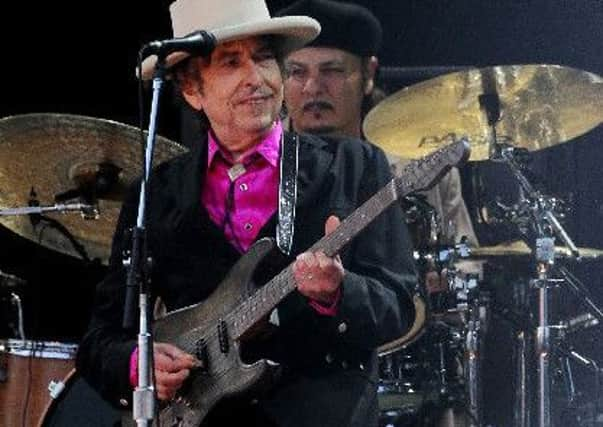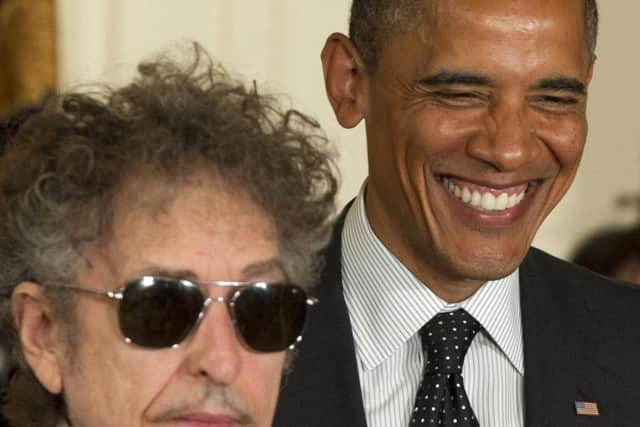Bob Dylan: Mr Tambourine Man turns 75


I remember watching Billy Bragg perform at a sun-drenched Glastonbury Festival 23 years ago.
Midway through his set he stopped and told the crowd he wanted to play a song that, for him, was more poetic than any of the verses he had been force-fed at school, and he promptly began singing the opening lines of Mr Tambourine Man.
Advertisement
Hide AdAdvertisement
Hide AdBragg wasn’t the first person to be inspired by the song. As well as launching the career of The Byrds it has also been covered by such disparate performers as Judy Collins, Stevie Wonder and William Shatner (yes, that William Shatner). The song was, of course, written by a certain Robert Zimmerman, aka Bob Dylan.


When it comes to the great pantheon of popular music Dylan has few rivals. In a career spanning six decades he redefined the way songs could be written and performed, became the poster boy of the folk scene during the 1960s and just so happened to be responsible for some of the greatest records ever made.
Even now, as he turns 75, Dylan remains an important figure. In 2012, Barack Obama presented him with a Presidential Medal of Freedom – the highest civilian award that can be bestowed on someone in the US.
He’s currently writing the follow-up to his acclaimed 2004 memoir Chronicles, and musically he still matters. Shadows in the Night topped the UK album charts last year, while his latest record Fallen Angels, released only last week, sees him delve into the great American songbook to widespread acclaim.
Advertisement
Hide AdAdvertisement
Hide AdDylan’s rise to global fame was as unlikely as it was meteoric. Just over 12 months after arriving in New York, where he had gone to visit his ailing hero, Woody Guthrie, he released his first album, Bob Dylan.


By this time he had already established himself in the folk dens of Greenwich Village, but he soon reached a far bigger audience. His politicised songs of protest and poetry chimed with a growing, and increasingly disaffected, youth culture on both sides of the Atlantic.
Dylan’s creativity during this mid-60s period is astonishing – even The Beatles were in awe of him. In less than 15 months he had released three albums, Bringing It All Back Home, Highway 61 Revisited and Blonde on Blonde, that irrevocably changed the face of popular culture.
Even during the 80s when his music seemed out of step with the times, he was still producing great songs like Blind Willie McTell, an out-take from his Infidels album, and Brownsville Girl.
Advertisement
Hide AdAdvertisement
Hide AdHe hasn’t been without his critics, though. His decision to plug-in his guitar and “go electric” alienated many of his folk fans.
Then came a motorcycle accident in 1966, at the height of his fame, which precipitated a period away from the spotlight. Music experts frequently cite this as a significant moment in Dylan’s life and certainly his next album, John Wesley Harding, was quieter and more contemplative.
In the 70s his output varied greatly. His albums received a mixed response until the sublime Blood on the Tracks, in 1975, which, for many fans, has become a benchmark against which all his subsequent records are judged.
Dylan has long been known for his Herculean touring schedule. In 1988, he embarked on what became known as “The Never-Ending Tour”, and today he continues to perform at a rate that few his of his peers can match.
Advertisement
Hide AdAdvertisement
Hide AdDr Simon Warner, lecturer in Popular Music Studies at the University of Leeds, says Dylan is one of the key figures in the history of popular music. “If you look at the giants of music in the 20th Century there’s Elvis Presley, Frank Sinatra, Louis Armstrong, The Beatles and Bob Dylan. He’s up there in that category.”
Dylan was influenced by Beat writers such as Jack Kerouac and Allen Ginsberg and brought a new dimension to folk and rock music.“He had this mission to bring poetry to lyricism that hadn’t been done before and he brought an intellectual approach to songwriting.”
Dr Warner says Dylan’s reputation was forged during a “golden” period stretching from his 1963 album The Freewheelin’ Bob Dylan through to Blood on the Tracks 12 years later. “He’s been a folk star, a rock star and a country star and through his work with the Band he created a template for what became Americana that still influences indie music and folk music today.”
During his career, he’s been labelled everything from a born-again Christian, to a folk icon and protest singer, whose songs have spoken for a generation. But unlike Elvis, who ended up a parody of himself, Dylan has always been master of his own ship and as he sails into his twilight years he does so having already created a musical legacy that will stand the test of time.